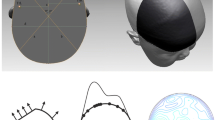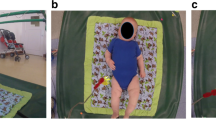Abstract
Cervical rotation deficit (CRD) and trunk convexity (TC) constitute the diagnosis of infantile postural asymmetry (IPA), which is often associated with further asymmetric features. However, very little data on the entire symptom complex are currently available. The aim of this study was to analyse the entire clinical spectrum of IPA based on a standardized video documentation. Forty-five infants (27 male) with an asymmetry score of ≥12 points (scale: 4–24) at a median post-term age of 10 weeks (range: 6–16) were selected from two previously studies using predefined criteria. CRD and TC as reactive movements to an orienting head turn in the prone and supine position were assessed from video recordings by three independent observers. Plagiocephaly, oblique body position and asymmetric foot position were descriptively assessed by consent of the same observers. Hip dysplasia data were derived from sonography charts. The assessment of the reactive movements showed a “scoliosis” pattern in sox infants, a “torticollis” pattern in nine infants, a “mixed prone” pattern in 13 infants and a “mixed” pattern in 26 infants. Side agreement in the prone and supine position of TC and CRD was seen in 27 infants, with a left-sided convexity and left-sided head rotation deficit in two-thirds of the infants. Plagiocephaly was present in 27 infants, oblique body position in 13 infants, hip dysplasia in 4 infants and calcaneus foot in 11 infants. In conclusion, infantile asymmetry pattern analysis showed that morphological and functional anomalies are intricately linked and that infants with only a single apparent sign of asymmetry have actually a much more generalized disturbance.







Similar content being viewed by others
Abbreviations
- CRD:
-
Cervical rotation deficit
- IPA:
-
Infantile postural asymmetry
- TC:
-
Trunk convexity
- TSC:
-
Total score difference
References
Argenta LC, Davis LR, Wilson JA, Bell WO (1996) An increase in infant cranial deformity with supine sleeping position. J Craniofacal Surg 7:5–11
Aufschnaiter D von (1999) Entwicklung und Entwicklungsdiagnostik. In: Hartmannsgruber R, Wenzel D (eds) Physiotherapie Pädiatrie Band 12. Georg Thieme Verlag, Stuttgart, pp 5–25
Behrman RE, Kliegman RM, Jenson HB (2000) Scoliosis, craniosynostosis, torticollis. In: Nelson textbook of pediatrics, 16th edn. W.B. Saunders Co., Philadelphia, pp 1812–1813, pp 2082–2086, pp 2089–2091
Binder H, Eng GD, Gaiser JF, Koch B (1987) Congenital muscular torticollis: results of conservative management with long-term follow-up in 85 cases. Arch Phys Med Rehabil 68:222–225
Boere-Boonekamp MM, Linden-Kuiper AT van der (2001) Positional preference: prevalence in infants and follow-up after two years. Pediatrics 107:339–343
Brett EM (1991) Paediatric neurology. 2nd edn. Churchill Livingstone, New York
Brodsky MC, Baker RS, Hamed LM (1996) Torticollis and head nodding. In: Pediatric neurophthalmology. Springer, Berlin Heidelberg New York, pp 351–368
Brunetaeu RJ, Mulliken JB (1992) Frontal plagiocephaly: synostotic, compensational, or deformational. Plast Recontr Surg 89:21–32
Canale ST, Griffin DW, Hubbard CN (1982) Congenital muscular torticollis. A long-term follow-up. J Bone Joint Surg Am 64:810–816
Cheng JC, Au AW (1994) Infantile torticollis: a review of 624 cases. J Pediatr Orthop 14:802–808
Davis BE, Moon RY, Sachs HC, Ottolini MC (1998) Effects of sleep position on infant motor development. Pediatrics 102:1135–1140
Flehmig I (2001) Normale Entwicklung des Säuglings und ihre Abweichungen. Georg Thieme Verlag, Stuttgart
Graf R (1984) Classification of hip joint dysplasia by means of sonography. Arch Orthop Trauma Surg 102:248–255
Gunturkun O (2003) Adult persistence of head-turning asymmetry. Nature 421:711
Hamanishi C, Tanaka S (1994) Turned head-adducted hip-truncal curvature syndrome. Arch Dis Child 70:515–519
Hunt CE, Puczynski MS (1996) Does supine sleeping cause asymmetric heads? Pediatrics 97:127–129
Kane AA Mitchell LE, Craven KP, Marsh JL (1996) Observations on a recent increase in plagiocephaly without synstosis. Pediatrics 97:877–885
Kapandji IA (1992) Funktionelle Anatomie der Gelenke. Enke, Stutgart
Kattwinkel J, Brooks J, Keenan MJ, Malloy M (1996) American Academy of Pediatrics; positioning and sudden infant death syndrome (SIDS): update. Pediatrics 98:1216–1218
Konishi Y, Mikawa H, Suzuki J (2002) Asymmetrical head-turning of preterm infants: some effects on later postural and functional lateralities. Dev Psychobiol 40:1–13
Lloyds-Roberts GC, Pilcher MF (1965) Structural idiopathic scoliosis in infancy: a study of the natural history of 100 patients. J Bone Joint Surg Am 47-B:520–523
Mau H (1968) Ist die sogenannte Säuglingsskoliose behandlungsbedürftig? Dtsch Med Wochenschr 43:2051–2053
McMaster MJ (1983) Infantile idiopathic scoliosis: can it be prevented? J Bone Joint Surg Am 65-B:612–617
Michel GF, Harkins DA (2001) Postural and lateral asymmetries in the ontogeny of handedness during infancy. Dev Neuropsychol 19:41–51
Niethard FU, Carstens C, Döderlein L, Peschgens T (1997) Kinderorthopädie. Georg Thieme Verlag, Stuttgart
Pang D, Veetai L. (2004) Atlantoaxial rotatory fixation: part 1 – biomechanics of normal rotation at the atlantoaxial joint in children. Neurosurgery 55:614–626
Philippi H, Faldum A, Bergmann H, Jung T, Pabst B, Schleupen A (2004) Idiopathic infantile asymmetry, proposal of a measurement scale. Early Hum Dev 80:79–90
Reiss M, Reiss G (1997) Lateral preferences in a German population. Percept Mot Skills 85:569–574
Rosegger H, Steinwendner G (1992) Transverse fetal position syndrome – a combination of congenital skeletal deformities in the newborn infant. Paediatr Paediol 27:125–127
Skiba M, Diekamp B, Gunturkun O (2002) Embryonic light stimulation induces different asymmetries in visuoperceptual and visuomotor pathways of pigeons. Behav Brain Res 134:149–156
St John D, Mulliken JB, Kaban LB, Padwa BL (2002) Antropometric analysis of mandibular asymmetry in infants with deformational posterior plagiocephaly. J Oral Maxillofac Surg 60:873–877
Thompson SK (1980) Prognosis in infantile idiopathic scoliosis. J Bone Joint Surg Am 62-B:151–154
Tunnessen W (1988) Asymmetry. In: Signs and symptoms in pediatrics 2nd edn JB Lippingcott, Philadelphia, pp. 509
Visscher F, Graaf T van der, Spaans M, Lingen RA van, Fetter WPF (1998) Prone position favorable for motor development of infants. Ned Tijdschr Geneeskd 142:2201–2205
Vojta V (2000) Die zerebralen Bewegungstörungen im Säuglingsalter. Hippokrates, Stuttgart
Walsh JJ, Morrissy RT (1998) Torticollis and hip dislocation. J Pediatr Orthop 18:219–221
Author information
Authors and Affiliations
Corresponding author
Additional information
This study was supported by MAIFOR Fund of the Johannes-Gutenberg University Mainz, Germany
Rights and permissions
About this article
Cite this article
Philippi, H., Faldum, A., Jung, T. et al. Patterns of postural asymmetry in infants: a standardized video-based analysis. Eur J Pediatr 165, 158–164 (2006). https://doi.org/10.1007/s00431-005-0027-6
Received:
Accepted:
Published:
Issue Date:
DOI: https://doi.org/10.1007/s00431-005-0027-6




